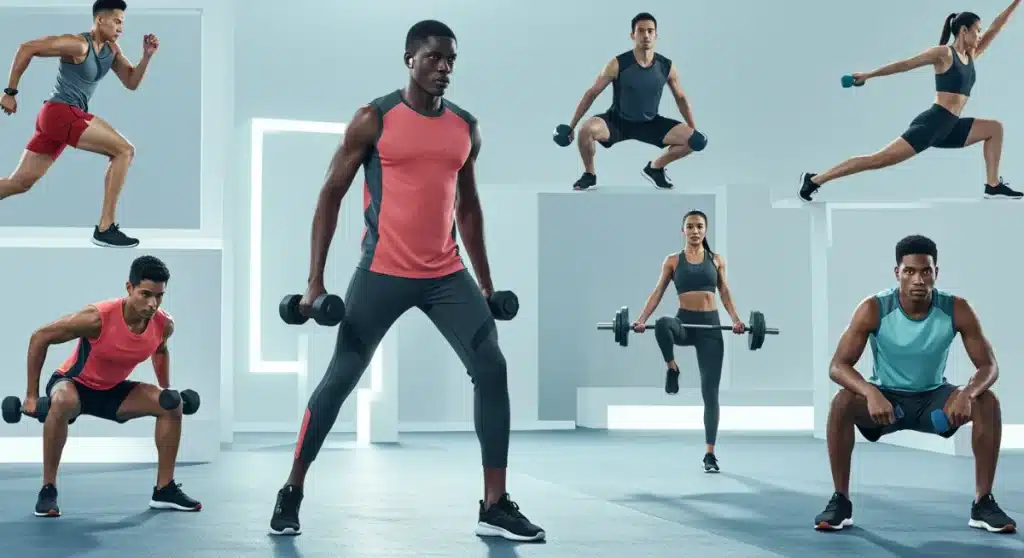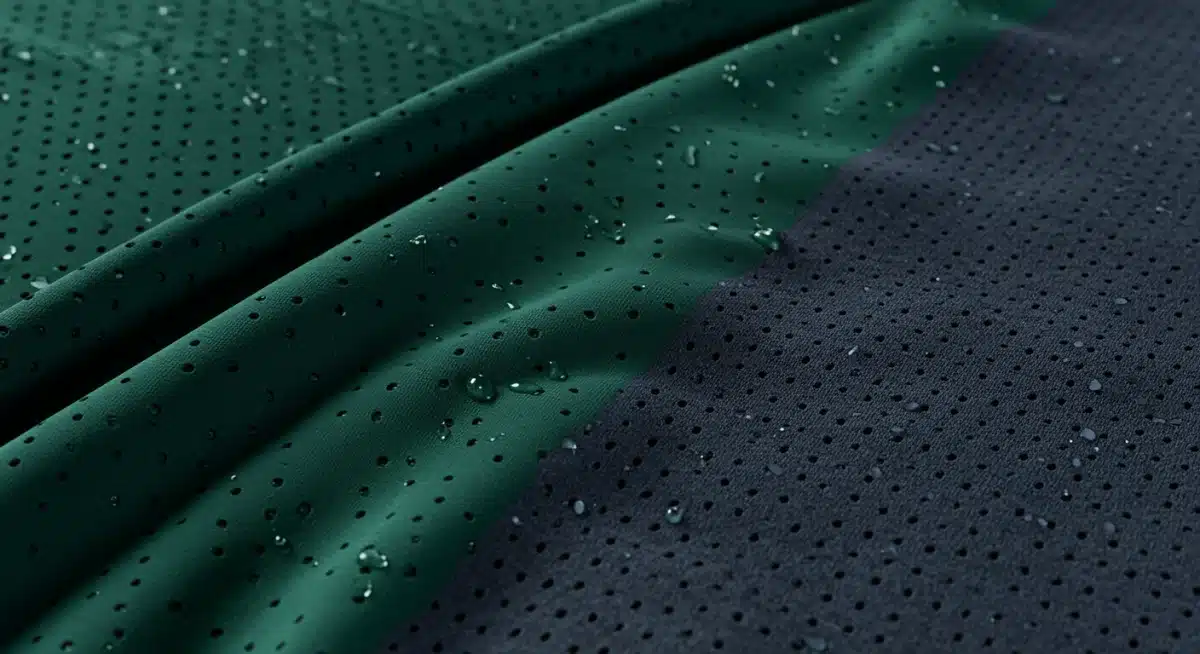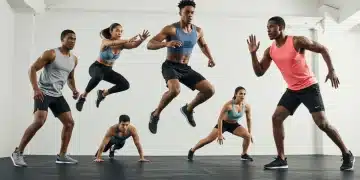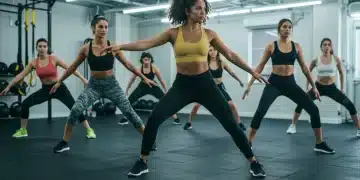Breathability vs. Compression: Top 4 Fitness Wear Lines in 2025

Anúncios
The 2025 fitness wear market is defined by a delicate balance between breathability and compression, crucial for enhancing athletic performance and comfort. This analysis reviews four top lines excelling in this critical synergy.
Anúncios
In the dynamic world of athletic apparel, the quest for optimal performance and comfort often boils down to a fundamental debate:
breathability vs compression. As we step into 2025, fitness wear brands are no longer choosing one over the other;
instead, they are ingeniously integrating both. This article delves into four prominent fitness wear lines that have masterfully balanced these two crucial elements,
offering athletes and enthusiasts an unparalleled experience.
The evolving science of fitness fabrics
The landscape of fitness apparel has transformed dramatically over the past decade, driven by innovations in material science and a deeper understanding of human physiology during exercise.
No longer are simple cotton tees or heavy sweats the norm. Today, athletes demand gear that actively supports their performance, recovery, and overall comfort.
Anúncios
This evolution is particularly evident in the sophisticated combination of breathability and compression. Breathable fabrics are designed to wick moisture away from the skin and allow air circulation,
preventing overheating and chafing. Compression garments, on the other hand, apply targeted pressure to muscles, aiming to improve blood flow, reduce muscle oscillation,
and potentially aid in recovery. The challenge for brands has been to create garments that offer the benefits of both without compromising either.
Material innovations driving the shift
The advancements in synthetic fibers and weaving techniques have been pivotal in achieving this equilibrium.
Engineered fabrics now feature multi-zone constructions, where different areas of a garment are designed with varying levels of breathability and compression.
- Smart Textiles: Fabrics that adapt to body temperature or sweat levels.
- Seamless Knitting: Allows for precise mapping of compression and ventilation zones.
- Hybrid Blends: Combining natural fibers with synthetics for enhanced properties.
- Recycled Materials: Sustainable options that maintain performance integrity.
These innovations are not just about aesthetics; they are about creating a second skin that works in harmony with the body.
The goal is to eliminate distractions caused by discomfort, allowing individuals to focus entirely on their training.
Understanding these foundational changes is key to appreciating the nuanced designs of the leading fitness wear lines in 2025.
Line 1: AuraFlow by Zenith Athletics
Zenith Athletics has consistently pushed the boundaries of performance wear, and their 2025 AuraFlow line is a testament to their commitment to innovation.
This collection is specifically engineered for high-intensity training, where both heat management and muscle support are paramount.
AuraFlow achieves an impressive balance through its proprietary ‘Z-Weave’ fabric technology.
The Z-Weave integrates ultra-fine, moisture-wicking threads with strategically placed mesh panels.
These panels are typically found in high-sweat areas like the armpits, back, and inner thighs, maximizing airflow and accelerating evaporation.
Simultaneously, the fabric’s core structure provides graduated compression, gently supporting major muscle groups without restricting movement.
Targeted compression zones
One of the standout features of AuraFlow is its intelligent compression mapping.
Instead of uniform pressure, the garments offer varying levels of compression across different muscle groups.
For instance, quadriceps and hamstrings receive firm support to reduce vibration during dynamic movements, while joints like knees and elbows benefit from lighter compression for flexibility.
- Quad & Hamstring Support: Reduces muscle fatigue and oscillation.
- Core Stabilization: Integrated compression panels in abdominal areas.
- Joint Flexibility: Lighter compression around major joints for full range of motion.
The breathability isn’t sacrificed for this support. The mesh panels are seamlessly integrated, feeling like a natural extension of the fabric rather than an add-on.
Athletes report a sensation of being both firmly held and completely unencumbered, a difficult feat to achieve.
AuraFlow truly exemplifies the cutting edge of balancing breathability and compression for demanding workouts.
Line 2: BioFit by KinetiX Gear
KinetiX Gear’s BioFit series for 2025 takes a biomechanical approach to fitness apparel, focusing on how fabric interacts with the body’s natural movements and thermal regulation.
Their core innovation lies in a new material called ‘Bio-Vent’, a fabric engineered at a molecular level to optimize both airflow and structural integrity.
Bio-Vent features a unique micro-perforation design that allows for exceptional breathability, releasing heat and moisture Vapor efficiently.
However, unlike traditional perforated fabrics that might compromise durability or compression, Bio-Vent maintains a robust structure.
This allows KinetiX to apply consistent, yet flexible, compression across the entire garment.

The design philosophy behind BioFit emphasizes a ‘second skin’ feel, where the garment moves as one with the wearer.
This is crucial for activities requiring extensive flexibility and range of motion, such as yoga, Pilates, or gymnastics, while still providing the benefits of compression for muscle support.
Adaptive compression and thermal regulation
BioFit garments are designed to adapt to the body’s changing needs during a workout.
As body temperature rises, the Bio-Vent fabric’s pores are said to subtly expand, increasing airflow.
Conversely, during cooler periods, they contract slightly, offering a degree of insulation without becoming stuffy.
- Dynamic Airflow: Micro-perforations adjust to body temperature.
- Uniform Compression: Consistent pressure across muscles for stability.
- Enhanced Flexibility: Fabric stretches in multiple directions without losing shape.
This adaptive quality makes BioFit incredibly versatile, suitable for a wide range of climates and activity levels.
The balance here is less about distinct zones and more about an intelligent, holistic fabric that inherently manages both breathability and compression throughout the garment, making it a strong contender in the breathability vs compression conversation.
Line 3: OmniStride by Velocity Performance
Velocity Performance’s 2025 OmniStride line is tailored for endurance athletes, particularly runners and cyclists, who require sustained comfort and performance over long periods.
Their approach to balancing breathability and compression focuses on minimizing drag and maximizing efficiency, crucial for competitive edge.
OmniStride utilizes a multi-layered fabric system known as ‘AeroComp’.
The inner layer, closest to the skin, is a highly breathable, hydrophilic material that rapidly wicks sweat away.
The outer layer is a more robust, hydrophobic compression fabric that provides targeted support while also being wind-resistant and quick-drying.
This layering strategy allows for efficient moisture management while maintaining a sleek, aerodynamic profile.
The compression elements are strategically placed to support key endurance muscles like the calves, glutes, and quadriceps, reducing muscle fatigue over extended efforts.
Strategic ventilation and muscle support
AeroComp’s design is highly specialized.
For example, running tights feature mesh ventilation channels along the spine and behind the knees, areas prone to heat build-up.
Compression is strongest in areas that benefit most from reduced muscle oscillation, like the lower leg to prevent shin splints.
- Dual-Layer System: Inner wicking, outer compression and wind resistance.
- Aerodynamic Fit: Designed to reduce drag for speed.
- Endurance-Specific Compression: Focus on calves, quads, and glutes.
The result is apparel that feels incredibly light and fast, yet provides substantial support.
Athletes wearing OmniStride report feeling cooler and experiencing less muscle soreness during and after long-distance activities.
Velocity Performance has clearly optimized their line for the unique demands of endurance sports, proving that a sophisticated balance of
breathability vs compression can directly translate to improved athletic outcomes.
Line 4: FlexWeave by Urban Athletics
Urban Athletics, known for its stylish yet functional designs, introduces the FlexWeave line in 2025, targeting the hybrid athlete who transitions seamlessly between gym workouts, studio classes, and urban exploration.
Their philosophy is to provide versatile apparel that doesn’t compromise on performance or aesthetic, making the balance of breathability and compression critical for daily wearability.
FlexWeave features a unique fabric construction that prioritizes comfort and freedom of movement above all else, without sacrificing the benefits of support and ventilation.
The ‘Adaptive Knit’ technology uses a blend of elastane and recycled polyester to create a fabric that is soft to the touch, highly stretchable, and surprisingly breathable.
The compression in FlexWeave is more gentle and adaptive than in performance-focused lines, offering a supportive embrace rather than a tight squeeze.
This makes it ideal for activities that require a broad range of motion and for individuals who prefer a less restrictive feel from their compression wear.
Versatility and everyday performance
The breathability in FlexWeave is achieved through microscopic channels within the knit, allowing air to circulate freely.
These channels are subtle and don’t detract from the fabric’s smooth, premium feel, making the garments suitable for both intense workouts and casual wear.
- Comfort-First Compression: Gentle, supportive fit for all-day wear.
- Subtle Ventilation: Microscopic channels for discrete airflow.
- Stylish Design: Aesthetic appeal for gym-to-street transitions.
FlexWeave garments are designed with a contemporary aesthetic, making them as suitable for a coffee run as they are for a CrossFit session.
Urban Athletics has successfully demonstrated that balancing
breathability vs compression doesn’t have to mean sacrificing style or everyday comfort, catering to a broader demographic of active individuals.
This line truly redefines what ‘athleisure’ can be in terms of integrated performance.
Choosing the right balance for your fitness journey
The array of choices in 2025’s fitness wear market highlights a significant shift:
the understanding that no single garment fits all needs.
The ideal balance between breathability and compression is highly personal and depends largely on your specific activities, intensity levels, and personal comfort preferences.
For high-intensity training or endurance sports, a line like AuraFlow or OmniStride might be more appropriate, offering robust compression and targeted ventilation.
If your activities are more varied, or if you prefer a softer, more flexible feel, BioFit or FlexWeave could be a better match.
It’s crucial to consider the fabric composition, the design of ventilation zones, and the type of compression offered before making a purchase.
Factors to consider before buying
Making an informed decision involves more than just looking at brand names.
Delve into the technical specifications and consider how the garment will perform under your typical workout conditions.
- Activity Type: Does your sport demand intense muscle support or maximum flexibility?
- Climate: Will you be training in hot, humid, or cooler conditions?
- Fit Preference: Do you prefer a tight, second-skin feel or a more relaxed, supportive fit?
- Recovery Needs: Are you looking for garments that aid in post-workout recovery?
Ultimately, the best way to determine the right balance for you is through personal experience.
Many brands now offer trial periods or extensive return policies, allowing you to test how different garments perform during your actual workouts.
Investing in quality fitness wear that perfectly marries
breathability vs compression is an investment in your performance, comfort, and overall enjoyment of your fitness journey.
The future of fitness wear: sustainability and smart integration
Looking beyond 2025, the trends in fitness wear suggest an even greater emphasis on sustainability and smart technology integration.
Brands are increasingly using recycled and eco-friendly materials, reducing their environmental footprint without compromising performance.
Furthermore, the integration of smart sensors into fabrics is becoming more sophisticated.
These sensors can monitor vital signs, track performance metrics, and even provide real-time feedback on form and technique.
Imagine a garment that not only supports your muscles and keeps you cool but also tells you if your running stride is efficient or if you’re overexerting yourself.
Key future trends
The innovation cycle in fitness apparel shows no signs of slowing down.
As technology advances, so too will our expectations for what our workout gear can do for us.
- Biodegradable Fabrics: Materials that break down naturally after their lifecycle.
- Integrated Biometrics: Apparel with embedded sensors for health monitoring.
- Personalized Fit: 3D scanning and printing for custom-tailored garments.
- Adaptive Materials: Fabrics that dynamically adjust to environmental changes.
The ongoing challenge for manufacturers will be to seamlessly integrate these advanced features while maintaining the core balance of
breathability vs compression that athletes have come to expect.
The future promises a highly personalized, environmentally conscious, and technologically advanced fitness wear experience that will redefine how we approach exercise.
| Fitness Wear Line | Key Balance Feature |
|---|---|
| AuraFlow by Zenith Athletics | Targeted compression with Z-Weave breathable mesh. |
| BioFit by KinetiX Gear | Adaptive Bio-Vent fabric for dynamic airflow and uniform compression. |
| OmniStride by Velocity Performance | Dual-layer AeroComp for endurance, inner wicking, outer compression. |
| FlexWeave by Urban Athletics | Comfort-first compression with subtle Adaptive Knit ventilation for versatility. |
Frequently asked questions about fitness wear
Breathable fitness wear helps regulate body temperature by allowing air to circulate and moisture to evaporate from the skin. This prevents overheating, reduces discomfort, and minimizes the risk of chafing, contributing to a more comfortable and focused workout experience.
Compression apparel supports muscles by reducing oscillation and improving blood flow. This can lead to decreased muscle fatigue, faster recovery times, and enhanced proprioception, allowing athletes to perform more efficiently and with greater stability during intense activities.
Yes, many modern compression garments, especially those designed with a softer, more adaptive fit like Urban Athletics’ FlexWeave, are suitable for casual wear. They offer light support and comfort, making them ideal for everyday activities or transitioning from the gym to other engagements.
Smart textiles are fabrics engineered with integrated technology, such as sensors or adaptive fibers, that can respond to environmental changes or physiological data. In fitness wear, they might monitor heart rate, track movement, or even adjust their breathability based on body temperature, offering real-time feedback.
Striking the right balance ensures that athletes receive both critical muscle support and effective thermal regulation. Too much compression without breathability can lead to overheating, while excessive breathability might compromise support. The ideal balance optimizes comfort, performance, and recovery simultaneously.
Conclusion
The 2025 fitness wear landscape clearly demonstrates that the perceived conflict between
breathability vs compression is now a synergistic partnership.
Leading brands like Zenith Athletics, KinetiX Gear, Velocity Performance, and Urban Athletics have pioneered innovative solutions,
each with a unique approach to integrating these two vital aspects of athletic apparel.
From targeted compression zones and adaptive fabrics to multi-layered systems and comfort-first designs,
the market offers sophisticated options for every type of athlete.
This evolution ensures that individuals can find gear perfectly suited to their specific needs,
enhancing performance, comfort, and the overall enjoyment of their fitness journey, while also paving the way for a more sustainable and technologically integrated future in activewear.





